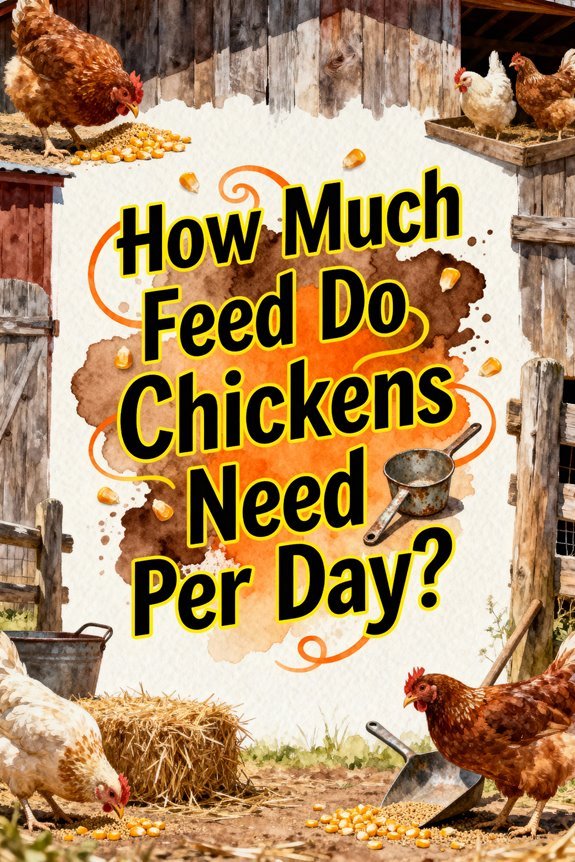Can Chickens Safely Eat Fresh and Cooked Green Beans?
While cooked green beans can provide your chickens with essential vitamins B2, B6, C, and K, raw green beans contain dangerous toxins called lectins and phytohaemagglutinin that can be fatal. You’ll need to thoroughly cook the beans and cut them into 1-2cm pieces, serving only 30-50 grams per chicken 2-3 times weekly. Proper preparation and portioning are vital, as even 3-4 raw beans could seriously harm your flock’s health. Understanding the full safety protocols will guarantee peak nutrition.
Understanding Raw Green Bean Risks for Chickens
While green beans can be a nutritious treat for chickens when properly prepared, raw green beans pose significant health risks due to their lectin and phytohaemagglutinin content. These toxins can bind to your chickens’ gut lining, interfering with nutrient absorption and causing severe digestive distress.
Similar to how cedar chemicals harm chickens’ respiratory systems, raw green bean toxicity manifests quickly, with phytohaemagglutinin effects proving potentially fatal. As few as three to four raw beans can cause death in chickens, primarily through red blood cell clumping and gastrointestinal damage. While some chickens may show varying tolerance levels, there’s no way to predict individual reactions. Just as chickens should avoid green tomato plants containing solanine toxins, raw green beans present similar dangers to your flock’s health. However, if chickens do consume raw green beans, they often remain relatively unharmed with careful observation. You’ll find no effective treatment once symptoms appear, making prevention vital. Though chickens might naturally avoid toxic plants, you shouldn’t rely on this instinct – it’s important to keep your flock away from raw green beans and their plants.
The Benefits of Cooked Green Beans in Chicken Diet
Unlike their raw counterparts, cooked green beans offer chickens a wealth of essential nutrients that support their overall health and development. The cooked benefits include significant vitamins B2, B6, C, and K, which enhance immune function, metabolism, and bone strength. You’ll find these vegetables particularly valuable for their iron and manganese content, supporting red blood cell production and energy metabolism. The adequate supply of dietary calcium from cooked green beans promotes strong eggshell formation. Just as leafy greens provide diverse nutrients when mixed with vegetables, green beans can be part of a balanced feeding plan.
Similar to how a chicken’s brain stem controls vital functions, maintaining proper nutrition through cooked green beans is essential for basic survival. When you feed your chickens cooked green beans, you’re providing them with important dietary fiber that improves digestion and gut health. The magnesium content aids in protein synthesis and energy production, while the fiber helps maintain healthy gut microbiota. These nutrients work synergistically to optimize your chickens’ metabolic efficiency, potentially improving their feed conversion rates and supporting sustained well-being throughout the day.
Safe Preparation Methods for Green Beans
How you prepare green beans for your chickens directly impacts their safety and nutritional value. You’ll need to thoroughly wash all green beans to remove harmful pesticides and herbicides, with organic options being the safest choice for your flock. When it comes to cooking techniques, you must fully cook the beans to deactivate toxic hemagglutinin and break down harmful lectins. Canned green beans should be avoided completely due to their excessive sodium content.
You can safely prepare green beans through boiling, steaming, sautéing, roasting, or microwaving – but maintain proper green bean hygiene by avoiding any additives. Don’t use salt, seasonings, or fats in the preparation process. Cut the cooked beans into manageable pieces and introduce them gradually while monitoring your chickens for adverse reactions. Like with crop impaction in chickens who consume too much hay, excessive green bean consumption can cause digestive issues. Much like collard greens, feeding green beans in excessive amounts can lead to poor egg quality. Remember to keep portions modest and serve them as an occasional treat rather than a dietary staple.
Proper Serving Sizes and Feeding Guidelines
When feeding green beans to chickens, proper portion control guarantees peak nutrition without disrupting their primary diet. You’ll want to limit servings to 30-50 grams of fresh green beans per chicken, offered 2-3 times weekly. This portion management approach makes sure green beans don’t exceed 10% of their daily vegetable intake. Before serving, ensure all beans are thoroughly rinsed before cooking like with human food preparation. Quality commercial layer feed should remain the foundation of their diet while vegetables serve as healthy supplements.
For ideal vegetable balance, chop fresh beans into 1-2 cm pieces to prevent choking, while cooked beans should be served in smaller 20-40 gram portions. You’ll need to monitor your flock’s response when introducing green beans, removing uneaten portions within 1-2 hours. Remember to adjust quantities based on your chickens’ size and laying status, and always rotate green beans with other vegetables to maintain dietary variety and complete nutrition. For laying hens, consider supplementing with oyster shells to support strong eggshell production alongside their vegetable intake.
Nutritional Value and Essential Vitamins
Green beans provide chickens with an impressive array of essential nutrients that support their overall health and egg production capabilities. The nutritional composition includes crucial vitamins A, C, K, E, and B-complex, which work in vitamin synergy to enhance immune function, metabolism, and bone health. Essential minerals like magnesium, iron, and potassium support cellular processes and electrolyte balance, while phosphorus aids bone formation and energy metabolism. Providing cooked green beans is crucial since raw beans contain harmful lectins that can be toxic to chickens. You’ll find these legumes contain beneficial omega-3 fatty acids, comprising about 5% of their fat content, which improve egg yolk quality and cardiovascular health. The high fiber content aids digestive health by supporting nutrient absorption and regular bowel movements. Similar to raw carrots, green beans can be safely grated or chopped to make them easier for chickens to consume. When incorporated into their diet, green beans’ diverse nutrient profile helps maintain your chickens’ overall robustness and laying performance.
Warning Signs of Bean-Related Health Issues
Monitoring your chickens for bean-related health issues requires vigilant observation of specific warning signs. The earliest toxic symptoms include vomiting, diarrhea, and abdominal discomfort. If you notice your birds displaying lethargy, uncoordinated movements, or wing weakness, these may indicate lectin poisoning from raw or undercooked beans.
For poisoning prevention, watch for respiratory distress, including open-mouth breathing, which can signal advanced toxicity. You’ll need to act quickly if you observe tremors, facial paralysis, or drooping eyelids, as these neurological symptoms suggest severe poisoning that can become fatal within 30-130 hours. Remember that proper cooking destroys harmful lectins – always boil beans for 10-20 minutes at 100°C before feeding them to your flock. The toxic compound phytohaemagglutinin in pinto beans can be safely neutralized through proper cooking, soaking, or sprouting methods.
Best Practices for Adding Green Beans to Feed
To maximize the nutritional benefits of green beans for your chickens, proper preparation and portion control are vital. Start by thoroughly cooking your green bean varieties through steaming, boiling, or light sautéing without oil to deactivate harmful lectins while preserving nutrients. Let them cool completely before serving. Raw beans contain toxic phytohaemagglutinin compounds that can harm chickens, making proper cooking essential.
Chop the beans into manageable pieces and introduce them gradually, limiting portions to a few beans per bird daily. You’ll want to rotate them with other vegetable treats to maintain dietary diversity. Always prepare green beans without seasonings or additives, and store any leftovers in airtight containers in the refrigerator.
For best results, incorporate fresh, properly washed green beans into your feeding routine, and discard any that show signs of spoilage or mold to guarantee your flock’s safety.
Seasonal Considerations for Green Bean Treats
When planning your chickens’ green bean treats throughout the year, seasonal variations greatly impact both availability and nutritional quality. You’ll find the best fresh green beans from May to September, when warm temperatures promote ideal bean maturation and higher nutrient concentrations.
Adjust your feeding approach based on the seasons. During peak summer months, fresh green beans can provide additional hydration, while you’ll need to reduce portions in colder periods when chickens’ digestion slows. Similar to the seasonal green beans found in Food 4 Fitness products, these vegetables offer excellent nutritional variety for your flock. Unlike spicy foods which chickens process through their capsaicin-free receptors, green beans require more careful portioning. Consider seasonal planting to align harvests with your flock’s natural cycles and nutritional needs.
Monitor for seasonal risks carefully. Rainy periods increase the chances of mold development, while warm, humid conditions can promote bacterial growth. Always inspect beans thoroughly and cook them to reduce naturally occurring compounds that could harm your chickens.
Alternative Vegetable Options for Variety
Diversifying your chickens’ diet beyond green beans opens up a wealth of nutritional opportunities through carefully selected vegetables. You’ll find excellent protein sources in kale and peas, while carrots deliver essential beta carotene when grated for easier digestion. For ideal vegetable diversity, incorporate nutrient-dense leafy greens like romaine lettuce and Swiss chard, which support egg-laying health.
Consider chicken preferences when choosing treats – many hens enthusiastically consume pumpkin flesh and seeds, which serve as natural dewormers. You can offer zucchini and cucumber for hydration, especially during warmer months. Offering suspended cabbage heads provides both a nutritious snack and engaging entertainment for your flock. Herbs like oregano, mint, and thyme provide both enrichment and dietary benefits. Remember to moderate certain vegetables – spinach contains oxalates that affect calcium absorption, while asparagus may alter egg flavors.

